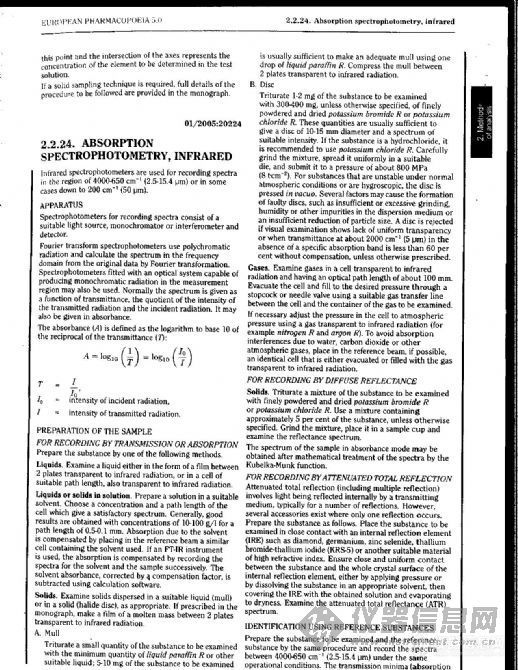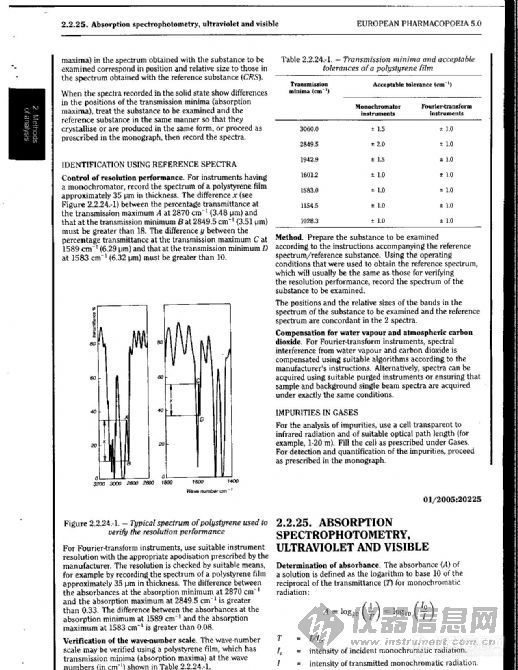
czq8
第3楼2007/10/06
这是根据你的图片识别的结果,中间可能是有错误的,所以应该是以你的图片为准,这里的文本仅供参考和查询方便目的。
2 2.24. ABSORPTION SPECTROPHOTOMETRY, INFRARED
Infrared spectrophotometers are used tor recording spectra in the region of 4000-650 cm"1 (2.5-15.4 pm) or in some cases down to 200 cm"1 (50 urn).
APPARATUS
Spectrophotometers for recording spectra consist of a suitable light source, monochromator or interferometer and detector.
Fourier transform spectrophotometers use polychromatic radiation and calculate the spectrum in the frequency domain from the original data by Fourier transformation. Spectrophotometers fitted with an optical system capable of producing monochromatic radiation in the measurement region may also be used. Normally the spectrum is given as a function of transmittance, the quotient of the intensity of the transmitted radiation and the incident radiation. It may also be given in absorbance.
The absorbance (A) is defined as the logarithm to base 10 of the reciprocal of the transmittance (T):
PREPARATION OF THE SAMPLE
FOR RECORDING BY TRANSMISSION OR ABSORPTION Prepare the substance by one of the following methods.
Liquids. Examine a liquid either in the form of a film between 2 plates transparent to infrared radiation, or in a cell of suitable path length, also transparent to infrared radiation.
Liquids or solids in solution. Prepare a solution in a suitable solvent. Choose a concentration and a path length of the cell which give a satisfactory spectrum. Generally, good results are obtained with concentrations of 10-100 g/I for a path length of 0.5-0.1 mm. Absorption due to the solvent is compensated by placing in the reference beam a similar cell containing the solvent used. If an FT-IR instrument is used, the absorption is compensated by recording the spectra for the solvent and the sample successively. The solvent absorbance, corrected by a compensation factor, is subtracted using calculation software.
Solids. Examine solids dispersed in a suitable liquid (mull) or in a solid (halide disc), as appropriate. If prescribed in the monograph, make a film of a molten mass between 2 plates transparent to infrared radiation. A. Mull
Triturate a small quantity of the substance to be examined with the minimum quantity of liquid paraffin R or other suitable liquid; 5-10 mg of the substance to be examined
is usually sufficient to make an adequate mull using one drop of liquid paraffin R. Compress the mull between 2 plates transparent to infrared radiation. B. Disc
Triturate 1-2 mg of the substance to be examined with 300-400 mg, unless otherwise specified, of finely powdered and dried potassium bromide R or potassium chloride R. These quantities are usually sufficient to give a disc of 10-15 mm diameter and a spectrum of suitable intensity. If the substance is a hydrochloride, it is recommended to use potassium chloride R. Carefully grind the mixture, spread it uniformly in a suitable die, and submit it to a pressure of about 800 MPa (8 tcnf *). For substances that are unstable under normal atmospheric conditions or are hygroscopic, the disc is pressed in vacuo. Several factors may cause the formation of faulty discs, such as insufficient or excessive grinding, humidity or other impurities in the dispersion medium or an insufficient reduction of particle size. A disc is rejected if visual examination shows lack of uniform transparency or when transmittance at about 2000 cm'1 (5 |Jm) in the absence of a specific absorption band is less than 60 per cent without compensation, unless otherwise prescribed.
Gases. Examine gases in a cell transparent to infrared
radiation and having an optical path length of about 100 mm. Evacuate the cell and fill to the desired pressure through a stopcock or needle valve using a suitable gas transfer line between the cell and the container of the gas to be examined. If necessary adjust the pressure in the cell to atmospheric pressure using a gas transparent to infrared radiation (for example nitrogen R and argon R). To avoid absorption interferences due to water, carbon dioxide or other atmospheric gases, place in the reference beam, if possible, an identical cell that is either evacuated or filled with the gas transparent to infrared radiation.
FOR RECORDING BY DIFFUSE REFLECTANCE
Solids. Triturate a mixture of the substance to be examined with finely powdered and dried potassium bromide R or potassium chloride R. Use a mixture containing approximately 5 per cent of the substance, unless otherwise specified. Grind the mixture, place it in a sample cup and examine the reflectance spectrum.
The spectrum of the sample in absorbance mode may be obtained after mathematical treatment of the spectra by the Kubelka-Munk function.
FOR RECORDING BY ATTENUATED TOTAL REFLECTION Attenuated total reflection (including multiple reflection) involves light being reflected internally by a transmitting medium, typically for a number of reflections. However, several accessories exist where only one reflection occurs. Prepare the substance as follows. Place the substance to be examined in close contact with an internal reflection element (IRE) such as diamond, germanium, zinc selenide, thallium bromide-thallium iodide (KRS-5) or another suitable material of high refractive index. Ensure close and uniform contact between the substance and the whole crystal surface of the internal reflection element, either by applying pressure or by dissolving the substance in an appropriate solvent, then covering the IRE with the obtained solution and evaporating to dryness. Examine the attenuated total reflectance (ATR) spectrum.
IDENTIFICATION USING REFERENCE SUBSTANCES
Prepare the substance to be examined and the reference substance by the same procedure and record the spectra between 4000-650 cm'1 (2.5-15.4 pm) under the same operational conditions. The transmission minima (absorption


czq8
第4楼2007/10/06
maxima) in the spectrum obtained with the substance to be examined correspond in position and relative size to those in the spectrum obtained with the reference substance (CRS).
When the spectra recorded in the solid state show differences in the positions of the transmission minima (absorption maxima), treat the substance to be examined and the reference substance in the same manner so that they crystallise or are produced in the same form, or proceed as prescribed in the monograph, then record the spectra.
Table 2.2.24.-1. — Transmission minima and acceptable
tolerances of a polystyrene film
IDENTIFICATION USING REFERENCE SPECTRA
Control of resolution performance. For instruments having a monochromator, record the spectrum of a polystyrene film approximately 35 urn in thickness. The difference x {see Figure 2.2.24.-1) between the percentage transmittance at the transmission maximum A at 2870 cm"1 (3.48 pm) and that at the transmission minimum Sat 2849.5 cm"1 (3.51 ym) must be greater than 18. The difference y between the percentage transmittance at the transmission maximum C at 1589 cm"' (6.29 pm) and that at the transmission minimum D at 1583 cm"1 (6.32 pm) must be greater than 10
Method. Prepare the substance to be examined according to the instructions accompanying the reference spectrum/reference substance. Using the operating conditions that were used to obtain the reference spectrum, which will usually be the same as those for verifying the resolution performance, record the spectrum of the substance to be examined.
The positions and the relative sizes of the bands in the spectrum of the substance to be examined and the reference spectrum are concordant in the 2 spectra.
Compensation for water vapour and atmospheric carbon dioxide. For Fourier-transform instruments, spectral interference from water vapour and carbon dioxide is compensated using suitable algorithms according to the manufacturer's instructions. Alternatively, spectra can be acquired using suitable purged instruments or ensuring that sample and background single beam spectra are acquired under exactly the same conditions.
IMPURITIES IN GASES
For the analysis of impurities, use a cell transparent to infrared radiation and of suitable optical path length (for example, 1-20 m). Fill the cell as prescribed under Gases. For detection and quantification of the impurities, proceed as prescribed in the monograph.
Figure 2.2.24.-1. — Typical spectrum of polystyrene used to verify the resolution performance
For Fourier-transform instruments, use suitable instrument resolution with the appropriate apodisation prescribed by the manufacturer. The resolution is checked by suitable means, for example by recording the spectrum of a polystyrene film approximately 35 pm in thickness. The difference between the absorbances at the absorption minimum at 2870 cm"1 and the absorption maximum at 2849.5 cm"1 is greater than 0.33. The difference between the absorbances at the absorption minimum at 1589 cm"' and the absorption maximum at 1583 cm"1 is greater than 0.08.
Verification of the wave-number scale. The wave-number scale may be verified using a polystyrene film, which has transmission minima (absorption maxima) at the wave numbers (in cm"1) shown in Table 2.2.24.-1.